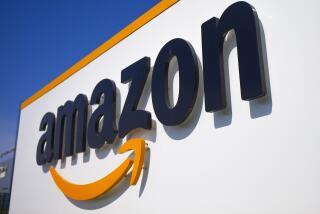Void of High-Tech Spending Could Stunt Recovery
WASHINGTON — It’s not that there aren’t other things to invest in. America has a long history of finding new gizmos to pump money into, from the steam engine to streaming video.
But the telecom giants that took another nose dive this week make some of the very machinery whose purchase by corporate America promised a happy double whammy: a boost in buying and the prospect of enhancement in the economy’s productivity or efficiency.
So news that companies are still spurning these purchases--leaving the giants stumbling--left many people shaken.
A failure by the corporate sector to resume its high-tech spending could stunt the nation’s still-nascent recovery.
“It’s stopped a lot of business executives and equity investors in their tracks,” said Los Angeles economist Donald H. Straszheim. “People just aren’t going to believe it’s time to go back to investing until telecom begins recovering.”
It was Monday’s spurt of discouraging telecom reports that prompted the fresh worries. The bankruptcy filing of once-hot Williams Communications Group Inc. came atop reports of major layoffs at wireless equipment maker Ericsson and telecom giant Lucent Technologies Inc. and a downbeat sales forecast from long-distance carrier WorldCom Inc
Although better-than-expected results at AT&T; Wireless Services Inc. and Verizon Communications Inc. Tuesday helped lift some of the industry gloom, it did little to restore confidence in the notion of a quick turnaround in corporate capital spending, which policymakers such as Federal Reserve Chairman Alan Greenspan have portrayed as crucial to recovery.
“What these latest problems show is we still have a long way to go in unwinding from the bubble years,” said Tony Crescenzi, chief bond market strategist at Miller Tabak & Co. in New York.
As Greenspan and company tell it, the nation managed to dodge a full-blown recession because of Fed interest rate cuts, a tax cut by Congress and the Bush administration and, most important, American consumers who kept on spending through the downturn.
The earliest benefits came in the final quarter of last year when, instead of shrinking as it had the quarter before, the economy expanded at a 1.7% annual rate. New benefits probably will appear Friday when the government releases its initial estimate of first-quarter growth. Forecasts range from 3% to better than 6%.
Even if growth comes in high, however, virtually every analyst acknowledges what the recovery really needs to prosper is for corporate America to go back to investing. But there are few signs most companies are prepared to do so and little understanding of what they would invest in.
Greenspan has said firms still have plenty of productivity-enhancing opportunities. And as recently as a year ago, the Fed chairman was explicit about what firms needed: more high-tech gear. He appeared to criticize suppliers such as Ericsson and Lucent for not being ready to provide more than they already were pumping out.
“It is not that underlying demand for Internet, networking and communications services has become less keen,” the Fed chairman asserted in congressional testimony a year ago February. “Instead ... some suppliers ... reacted late to accelerating demand.”
Greenspan’s enthusiasm for high tech seems almost quaint from today’s vantage point. His continued reliance on a capital spending revival may be unrealistic, several analysts said.
“There’s no application that’s so compelling right now that corporate America is going to pour a lot of money into technology,” said Howard Anderson, a veteran venture capital investor and head of Cambridge, Mass.-based YankeeTek Ventures. “Companies are doing just what they should be doing, which is sitting on their hands.”
Bullish forecasters assert that there are investments that companies can make without entering the high-tech quagmire, ones that will help boost growth and improve corporate efficiency. For example, heavy-truck sales are rising, said Richard Berner, chief U.S. economist with Morgan Stanley & Co. in New York, and new semiconductor orders indicate that computer production is climbing.
But these forecasters acknowledge that the economy’s well-being will continue to depend on consumers rather than companies for a considerable period to come.
Until corporate investment bounces back, the tech and telecom sectors will continue to languish, and so, some worry, will the economy.






